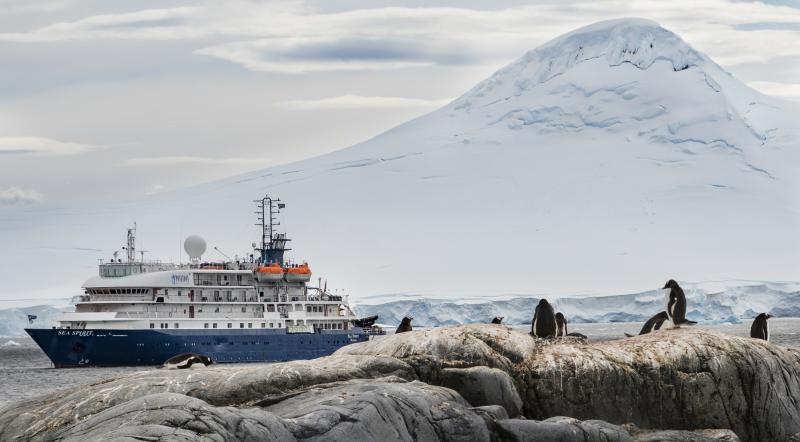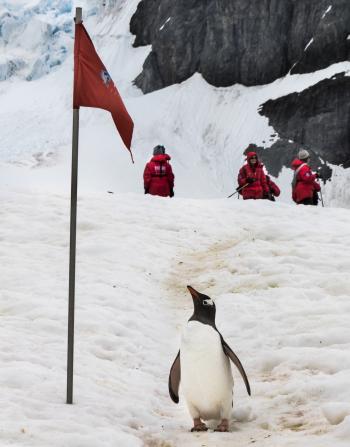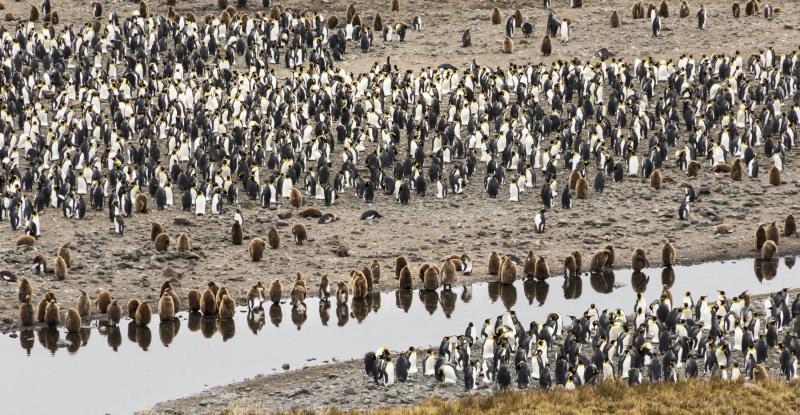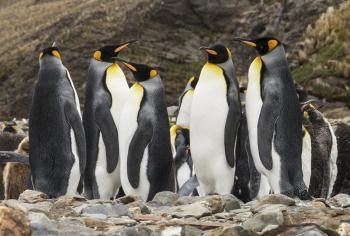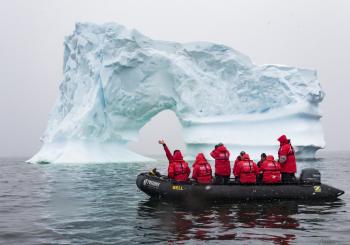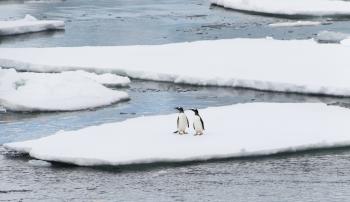Enjoying the spectacular scenery of Antarctica and South Georgia Island
This article appears on page 6 of the October 2017 issue.
Antarctica has long been on my travel bucket list, but after learning of the wildlife wonders of South Georgia Island, I was torn. Which destination should I choose?
Fortunately, Jessica at Adventure Life found an expedition that offered an itinerary to the Falkland Islands, South Georgia, Antarctica and the South Shetland Islands. This would entail spending 20 days aboard the Sea Spirit, with half of those being at-sea days, but (with luck) my husband, Steve, and I could get to both of my desired destinations on the same voyage.
Through Adventure Life (Missoula, MT; 800/344-6118, www.adventure-life.com), we booked a cabin on the Sea Spirit, a 114-passenger ship operated by Poseidon Expeditions. The cost for the January 2017 trip was $19,595 per person for the Classic cabin we reserved, with a 10% discount for early booking.
This included one night in Ushuaia, Argentina, at a luxury hotel and 19 nights on board the vessel. Airfare to Ushuaia was not included.
Starting out
It was not easy to get to Ushuaia, in the Tierra del Fuego area at the tip of South America. From the US, it was necessary to fly to Buenos Aires, Argentina, then take one of the South American airlines to Ushuaia.
Because we wanted to fly business class on the overnight portion, we flew Delta Air Lines from Atlanta to Miami, then Aerolineas Argentinas from Miami to Buenos Aires and on to Ushuaia.
Although it was considerably cheaper (roughly $2,500 per person, about half the price I saw from other airlines) to fly Aerolineas Argentinas to Buenos Aires, the plane was not in very good shape, and there was no working entertainment system. The flights to and from Ushuaia were changed, dropped or rescheduled several times.
When booking the flights, I Googled Aerolineas Argentinas, and the site that came up was www.one travel.com/Aerolineas/reservations. This is NOT the airline’s website. I made the mistake of booking through OneTravel, which meant that every time the airline canceled or changed a flight, I had to rebook it through OneTravel. I also had to pay an extra fee to reserve my seats.
I didn’t want to take a chance on missing our ship, so we arrived in Ushuaia a day earlier than required. This also gave us time to rest up from the 28 hours of travel from Atlanta to Ushuaia.
We stayed at the same hotel that Poseidon had booked for the following night, Arakur Ushuaia, paying $275 for the extra night. The hotel was lovely, perched on a hill in a nature reserve and overlooking the town. I enjoyed the outdoor hot tub and infinity pool with views of the sea.
Ushuaia is known for its seafood, but we found it easier to just enjoy the hotel buffet in the evening, especially the delicious Argentine lamb.
On the day of our departure, Poseidon offered a 5-hour tour of Tierra del Fuego National Park for an additional $95 per person. It was interesting but not spectacular. However, at that point we had spent so much money, what was another $200? We were only going to be there once.
At about 4 p.m., we were taken to board the ship.
The ship
The Sea Spirit was a very nicely appointed vessel. Our Classic cabin on Deck 3 was roomy, with a sofa and a chair as well as a king-sized bed formed by putting two singles together. There was ample storage and a small bathroom with an excellent shower.
Our window gave us a nice view, although, being close to sea level, it remained quite dirty during the voyage, which was really the only drawback to the spot we had chosen.
We were amidships, so we had a smoother ride than people in the bow or people on the higher decks. The cabins on Deck 2 had portholes. Deck 4 cabins had windows that stayed cleaner, but the entire deck was a promenade, so people were frequently walking by or blocking the view from those rooms. The cabins on Decks 5 and 6 had balconies but experienced much greater sway in rough weather. Considering these drawbacks, I was very pleased with our location.
The food on the ship was quite good. Breakfast and lunch were buffet-style, and the dinner menu featured four choices of entrée each night. Wine and beer cost extra, $7 each. We had fresh vegetables and fruit throughout the voyage, with much conversation among the passengers as to how they were able to serve us fresh lettuce every night. And, of course, the desserts were so tempting that I gained 4 pounds, in spite of the rigors of our excursions.
Coping with the weather
Every day, we convened in the common area for a recap of the previous day and a preview of the next day’s activities. Because every landing depended on weather conditions, particularly the wind and ocean swells, we were warned that there would always be a Plan A and a Plan B. In fact, we got an early taste of this variability when it was announced on the first night that we would be doing the trip in reverse, heading first to Antarctica due to storms in the Falklands and South Georgia.
Each night, our expedition leader huddled with the captain to decide what would be the likeliest landing spot the next day. In addition to the weather, they also had to factor in the locations of other ships in the area.
In Antarctica and South Georgia, only 100 people are allowed at any one landing spot at a time. Because 14 of our passengers were also kayakers, we were almost always able to go ashore as a group and not be left out of any of the landings.
I’d heard a lot about the dreaded Drake Passage from friends, but our crossing was reasonably smooth. (Steve thought it was completely smooth because he slept through the whole night!)
We were fortunate that neither of us felt seasick on the voyage, but many passengers did wear patches. I packed patches and other medication that I didn’t use, but these things were also available from the ship’s doctor.
Going ashore entailed elaborate preparation. We were required to wear waterproof pants. The Wellington boots that were also required were provided on loan, and the red parkas issued on the ship were ours to keep.
Of course, we always had to wear life jackets while in the Zodiacs (inflatable boats), and we had to disinfect our boots on leaving the ship as well as scrub them thoroughly when reboarding.
The temperature was not particularly cold, usually hovering around freezing, but when the wind was high, it felt bitter. My favorite piece of outerwear was my neck gaiter, which I could pull up over my face or use to cover my ears.
I took heavy ski gloves but found it impossible to use my camera with them on. Unfortunately, my thinner gloves were not waterproof, so I did find my hands getting uncomfortably cold.
For the coldest or windiest days, I wore the following: two pairs of socks, long underwear, slacks, waterproof pants, a long-underwear top, a long-sleeved shirt, my parka, my neck gaiter and gloves. Except for my hands, I was never cold. However, once we started our hikes or climbs up the ice and snow-covered hills, it was easy to get overheated, hence the advice to always wear layers.
On land
After a 2-day crossing of the Drake Passage, we reached the Shetland Islands for our first landing. It was snowing, but fortunately I had brought a rain cover for my DSLR camera. I also carted a tripod around with me (which my dear husband usually carried), but I used it only a few times on the trip. It did come in handy as a walking stick.
A light, water-resistant day pack was an important accessory.
The wildlife viewing was exciting. We saw petrels, albatrosses and humpback whales on the Drake crossing and gentoo, chinstrap and occasionally Adélie penguins plus Weddell, crabeater and elephant seals on the Shetland Islands.
The penguins and seals seemed oblivious to our presence. Although we were required to try to keep 15 feet from them, some of the penguins did not understand the rules and moved in closer.
We saw penguins on their nests, new chicks in their fluff and even a chick actually in the process of hatching. We also saw a rare leucistic penguin, which was all white except for a few light-gray patches.
On the fifth day of our voyage we landed at Orne Harbor, our only continental landing. We climbed a steep, ice-covered hill that the guides had scouted in advance so we could avoid any crevasses in the glacier. There was little wildlife to photograph there, but we had made it to the Antarctic continent!
I hoped we would be sailing through the Lemaire Channel, which is known for its spectacular icebergs, but we didn’t get that far south. However, we did pass through another channel with beautiful glaciers and icebergs just as the sun was setting, casting a wonderful, golden light on the sculpted forms.
One of the adventures offered on the trip was a Polar Plunge. Hardy passengers dove off the ship into the frigid water, each with a lifeline firmly attached to their waist. Both Steve and I abstained from this activity, but when a second opportunity was presented at one of the few sand beaches, Steve stripped off his outer clothing and ventured in up to his thighs. The water was 1°C (33.8°F)!
South Georgia
As we left Antarctic waters and headed toward South Georgia, we stopped at Deception Island, which offered unusual photo opportunities — white glaciers contrasting with the black volcanic soil. We also had a rare opportunity to take a Zodiac around Point Wild on Elephant Island, where Ernest Shackleton and his crew took refuge after losing their ship, the Endurance, in 1915.
Crossing from the Antarctic Peninsula to South Georgia through the Scotia Sea was an even longer transit than crossing the Drake had been.
During our sea days, the expedition team kept us busy with lectures on the geology, biology and history of the area. We also had a birding expert and a professional photographer on board, both of whom offered lectures on their areas of expertise (and they were very helpful when we were on land).
South Georgia is even more remote than Antarctica, lying more than 1,100 miles from South America in the middle of the South Atlantic, thus it receives far fewer visitors. The only way to get around the island is by boat or on foot, and there are no airports or accommodations on land.
What, then, are the attractions there? Our first stop was Cooper Bay, where we were cautioned about an activity termed “hiking.” Though we were warned that the terrain was very steep, rocky and muddy, calling it a hike was somewhat misleading. It was more like a “rock scramble.”
I tried the hike because I wanted to photograph the macaroni penguins, which nested in the tufted interior. I did get my photo, but I also sprained my knee when I slipped in the mud in my awkward Wellington boots. By the end of the day, only a couple dozen passengers had qualified to go on the next day’s “hike.”
Penguin encounters
That afternoon we visited St. Andrews Bay, one of the highlights of the trip. Spread out across the valley were 150,000 breeding pairs of king penguins, a close relative of the slightly larger emperors. The birds vied for territory with rather aggressive fur seals and somnolent elephant seals.
We could smell the birds even before we saw them. The chicks were still brown fur balls, not yet having grown into their tuxedo plumage.
The following day we visited Grytviken, a defunct whaling station with a small museum administered by the South Georgia Heritage Trust. Shackleton’s remains are buried in the small cemetery there.
We were also lucky enough to visit Prion Island, a breeding site for the wandering albatross. A boardwalk provided a small platform for viewing, but the birds nest quite far apart from each other, so photo opportunities were rare.
However, the fur seals were plentiful and eager to check us out… sometimes a little too eager. Occasionally, they had to be chased off with sticks!
Falkland Islands
Several more days at sea delivered us to Stanley in the Falkland Islands. This was the first town we had seen since we left Ushuaia, and the ship reloaded with supplies while we ventured into town.
The weather was extremely variable, going from rainy to sunny to windy to rainy again, all within a few hours.
Our tour included a visit to the interesting museum there.
We had two more days of landings in the Falklands, where we saw over 100,000 breeding pairs of black-browed albatrosses interspersed with rockhopper penguins and cormorants. We also spied a number of Magellanic penguins in their burrows.
The islands were quite beautiful and free of snow at that time of year.
Returning to Ushuaia, we enjoyed watching the Cape petrels as they flew alongside our ship. They were almost as large as the albatrosses.
Early the next morning, we were given the choice of storing our luggage off-ship for later retrieval or going directly to the airport, as the crew was already preparing the ship for another voyage that would leave that same afternoon.
Our flight back from Ushuaia landed at the domestic airport in Buenos Aires, AEP. Our international flight left from the city’s other airport, EZE. If flying Aerolineas Argentinas for both flights, there is a free shuttle bus between the two airports, but you have to get a voucher online before you can pick up the free ticket at the AEP airport. Otherwise, you’ll have to pay for the bus or take a more-expensive taxi.
We had a fairly long layover, as our flight back to the States didn’t leave until 11:30 p.m. The BA airport did not have a lot of choices for dining, and the business-class lounge for Aerolineas Argentinas did not offer much in the way of food. I’d recommend the pizza place in the airport.
Lessons learned
I learned a few things, should I ever decide to do another voyage like this (perhaps to the Arctic).
I wished I had taken a thin pair of waterproof gloves. The ski gloves, while warm, were too bulky.
Before we left, we bought thermal sole inserts for our boots, and I would recommend them, as they made the boots more comfortable as well as warmer.
The parkas were very bulky. We had to wear them on the plane back, as I had not packed a folding bag to carry them in. We looked a little silly when we landed in Miami.
The provided packing list recommended two pairs of long underwear, but one would have been sufficient, as it was easy to wash out clothes. One pair of waterproof pants was also sufficient. I had packed ski pants, but we never wore them.
The instructions also suggested a sport coat for men for the “captain’s dinner,” but that turned out to be quite unnecessary, as it was only a “captain’s cocktail” and most people did not dress up. (We did not pack dressy clothes, as I like to travel with a carry-on only.)
All in all, it was a wonderful trip, and the travel agency, crew and expedition team all made it a great adventure.

